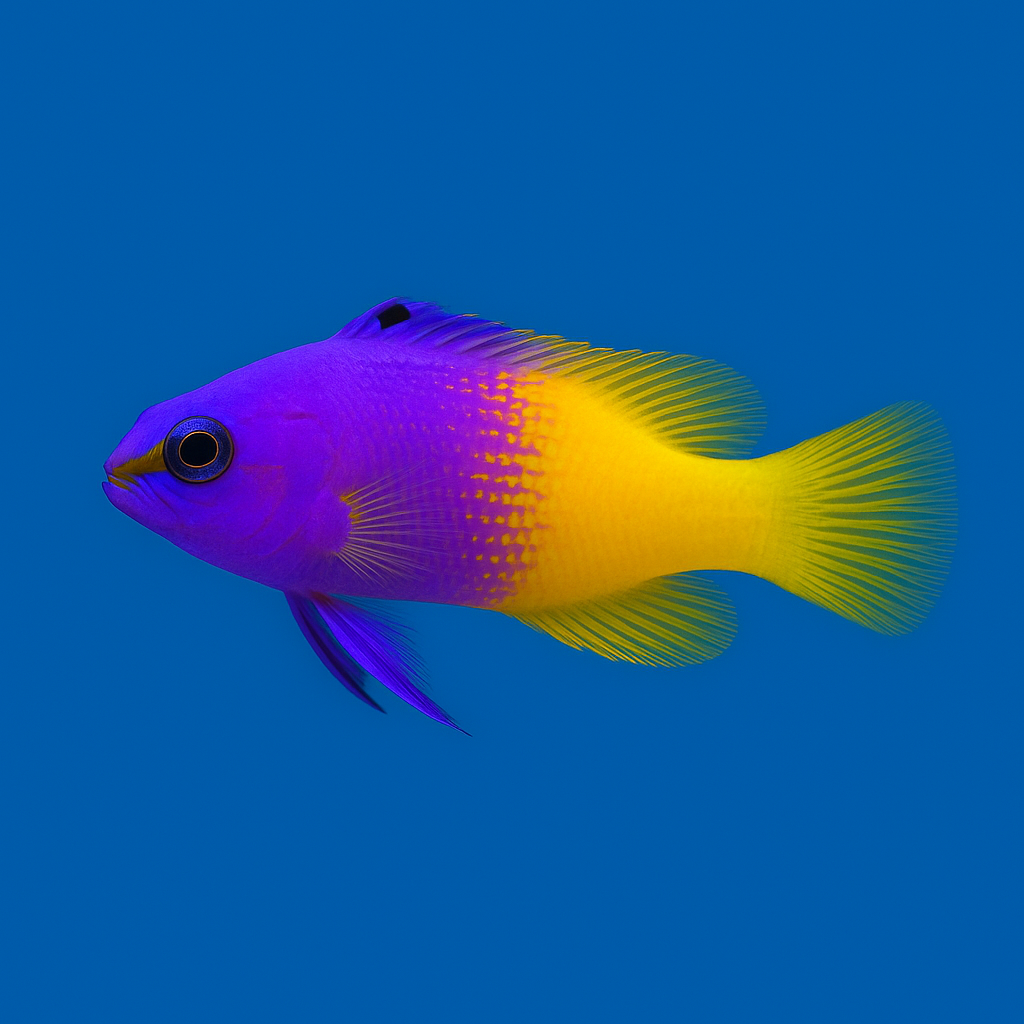
Royal Gramma (Gramma loreto): A Colorful and Hardy Addition to Your Reef Aquarium
If you're on the lookout for a hardy, peaceful, and eye-catching fish for your reef aquarium, the Royal Gramma (Gramma loreto) should be at the top of your list. Known for its vibrant purple and yellow coloration and manageable care requirements, this small saltwater fish is a long-time favorite among reef hobbyists across Canada.

In this guide, we’ll explore what makes the Royal Gramma such a great reef-safe option, how to care for one, and tips for integrating it into your saltwater tank. Whether you're just getting started with your reef setup or expanding your aquatic community, the Royal Gramma offers the perfect mix of beauty and practicality.
What is a Royal Gramma?
The Royal Gramma, scientifically known as Gramma loreto, hails from the tropical waters of the Caribbean and Western Atlantic. It belongs to the basslet family and typically reaches about 3 inches (7.5 cm) in length when fully grown.
What sets the Royal Gramma apart is its stunning coloration: the front half of its body is a vivid purple, while the back half transitions into a rich, golden yellow. This natural gradient makes it one of the most visually striking additions to any reef aquarium.
Why Royal Grammas Are Ideal for Reef Aquariums
Here are several reasons why this species is an excellent choice:
-
Reef-safe: The Royal Gramma poses no threat to corals, invertebrates, or most tank mates, making it perfectly compatible with mixed reef setups.
-
Low aggression: While territorial around its cave or hiding spot, it generally keeps to itself and doesn’t bully other fish.
-
Hardy and adaptable: It can tolerate a range of water parameters, which is ideal for beginner to intermediate hobbyists.
-
Small footprint: With its modest size and calm demeanor, it’s suitable for nano and mid-sized reef aquariums.
Habitat Setup & Tank Requirements
The Royal Gramma thrives in a well-established reef aquarium with plenty of live rock and hiding places. Here’s a quick checklist:
-
Minimum tank size: 30 gallon aquarium
-
Temperature: 72–78°F (22–25.5°C)
-
pH: 8.1–8.4
-
Salinity: 1.020–1.025 SG
-
Aquascape: Caves, crevices, and shaded areas
Royal Grammas are naturally shy and will often retreat to their favorite rockwork nook. If your aquascape allows for multiple hiding spots, it helps reduce any territorial disputes, especially in multi-fish setups.
Feeding and Nutrition
Royal Grammas are carnivorous and thrive on a protein-rich diet. In the wild, they feed on zooplankton and small crustaceans. In captivity, they do well with a variety of prepared and frozen foods, such as:
-
Brine shrimp
-
Marine pellets and flakes (preferably with high protein content)
At Reef Supplies, we carry a wide selection of reef-safe fish food perfect for Royal Grammas and other carnivorous species. Feeding 1–2 times per day is ideal, with just enough food that can be consumed within a couple of minutes.
Tank Mates and Behavior
Though peaceful, Royal Grammas can become territorial—especially if they feel their cave or corner is being invaded. That said, they generally do well with:
-
Clownfish
-
Gobies
-
Wrasses
-
Cardinalfish
-
Shrimp, crabs, and other invertebrates
Avoid housing them with larger, aggressive fish like triggers or large angelfish that might see them as a snack. Also, avoid pairing them with other basslets unless the tank is large and offers plenty of separation.
Common Issues and Health Tips
Royal Grammas are quite resilient, but like all marine fish, they are still susceptible to certain conditions:
-
Ich (Cryptocaryon): White spots and scratching on rocks can be an early sign. Quarantine new fish when possible.
-
Stress from tank mates: Overly aggressive fish or lack of hiding places can cause stress and illness.
-
Poor water quality: Like all reef inhabitants, they need stable parameters and low nitrates.
Perform regular water changes and monitor parameters using reliable test kits. Need help finding the right tools? Check out our selection of reef aquarium test kits and water conditioners on our website.
Breeding Behavior in Captivity
While breeding Royal Grammas in a home aquarium is rare, it has been achieved under specific conditions. Males will guard a nest and care for fertilized eggs. However, this usually requires a dedicated breeding tank and expert knowledge, and may not be feasible for the average reef keeper.
Fun Facts About the Royal Gramma
-
When threatened, they’ll often swim upside down inside their cave to confuse predators.
-
Their vibrant coloration fades slightly at night or when stressed—but don’t worry, it returns once they feel safe.
-
They’re sometimes confused with the Royal Dottyback, which is more aggressive and not reef-safe. Always check the Latin name (Gramma loreto) to be sure you’re getting the right fish.
Ready to Add a Royal Gramma to Your Reef?
While Reef Supplies doesn't sell live fish, we do offer everything you need to create the ideal environment for your Royal Gramma (Gramma loreto). From high-quality foods to live rock, aquascaping tools, and filtration systems, we’re here to support your reefing journey.
Need help finding the right products or setting up your reef aquarium? Contact us here or browse our reef aquarium essentials to get started.
Conclusion
The Royal Gramma is a showstopper in any reef aquarium, offering color, character, and compatibility. Whether you're building your first saltwater setup or adding to a mature reef system, this hardy little basslet checks all the boxes.
From gear to guidance, Reef Supplies is proud to support Canadian reefers with top-tier products and expert advice—no coral, no fish, just everything you need to keep them thriving.

